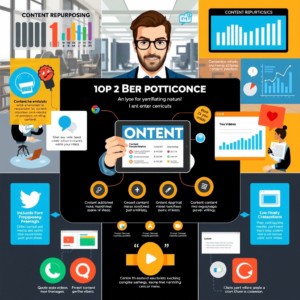In today’s fast-paced digital world, creating great content isn’t enough — you need to prove its value.
That’s where Key Performance Indicators (KPIs) come into play.
Imagine spending hours crafting blog posts, social media updates, and video scripts, only to wonder if any of it is making an impact. Are your efforts driving traffic? Converting leads? Building brand awareness? Without clear metrics, it’s nearly impossible to tell.
This is the reality many marketers face when they overlook the importance of KPIs. In this article, we’ll explore how to measure content marketing success using the right KPIs. You’ll learn not just what to track, but why each metric matters and how it ties directly to your business goals.
Whether you’re a small business owner, a marketing professional, or a solopreneur building your personal brand, understanding these KPIs can transform your strategy from guesswork to goal-driven success.
Let’s dive in.
1. Why KPIs Matter in Content Marketing
At its core, content marketing is about delivering valuable, relevant, and consistent information to attract and retain a clearly defined audience. But without measurable results, even the best content can go unnoticed.
KPIs act as your roadmap. They help you understand what’s working, what needs improvement, and where to allocate resources for maximum impact.
Think of KPIs like a GPS system for your marketing efforts. Just as you wouldn’t drive across the country without directions, launching content campaigns without tracking progress is risky — and inefficient.
For example, imagine publishing 20 blog posts in a month with no way to know which ones brought in traffic, generated leads, or boosted sales. That’s like shooting arrows in the dark and hoping one hits the bullseye.
KPIs give you clarity. They turn abstract ideas like “engagement” or “brand awareness” into actionable insights. And more importantly, they help justify your marketing budget by showing real ROI.
So, whether you’re aiming to boost website traffic, increase conversions, or build customer loyalty, choosing the right KPIs will make all the difference.
2. Common KPIs for Measuring Content Marketing Success
Now that we’ve established why KPIs are essential, let’s look at some of the most commonly used metrics in content marketing.
Website Traffic
One of the first signs that your content is resonating is increased traffic. Tools like Google Analytics allow you to track total visits, unique visitors, and referral sources. This helps you see which channels (like SEO, social media, or email) are driving the most eyes to your content.
Engagement Metrics
Engagement tells you how people interact with your content. These include:
- Time on page
- Bounce rate
- Page views per session
- Social shares
- Comments
High engagement means your content is capturing attention and keeping users interested — a strong indicator of relevance and quality.
Conversion Rate
Ultimately, content should guide users toward taking action. Whether it’s signing up for a newsletter, downloading a whitepaper, or making a purchase, conversion rates show how effective your content is at moving people through the buyer’s journey.
Lead Generation
Content often plays a role in lead generation. Tracking form fills, demo requests, or contact submissions helps you understand how well your content nurtures potential customers.
Each of these KPIs gives you a piece of the puzzle. Together, they paint a full picture of your content’s performance — and where you can improve.
3. Aligning KPIs with Business Goals
It’s tempting to track every metric available, but not all KPIs are created equal. The key is to align your measurements with your specific business objectives.
If your main goal is brand awareness , focus on reach, impressions, and social shares. If you’re aiming for lead generation , track landing page conversions, email sign-ups, and form completions.
Here’s a simple framework to help you choose the right KPIs:
Aligning your KPIs with your goals ensures you’re not just collecting data — you’re collecting the right data.
Another important consideration is the stage of the customer journey your content targets. Top-of-funnel content might aim for high reach and engagement, while bottom-of-funnel content should be optimized for conversion and retention.
By tailoring your KPIs to your goals and audience needs, you create a focused, results-driven content strategy.
4. Advanced KPIs for Deeper Insights
Once you’ve mastered the basics, it’s time to level up with more sophisticated KPIs that offer deeper insights into your content performance.
Customer Lifetime Value (CLV)
CLV measures how much revenue a customer brings over their lifetime. By connecting content touchpoints to long-term customer behavior, you can determine which pieces contribute most to lasting relationships and profitability.
Return on Investment (ROI)
While harder to calculate, ROI is the ultimate KPI for proving the value of your content marketing. It considers both the costs of production and distribution, along with the revenue generated. A positive ROI means your content is paying off — literally.
Search Engine Rankings
Tracking keyword rankings shows how well your SEO-optimized content performs in search results. Higher rankings typically mean more organic traffic and visibility.
Content Engagement Score
Some tools aggregate multiple engagement signals (time on page, shares, comments, etc.) into a single score. This allows you to compare different types of content and quickly identify top performers.
These advanced KPIs require more setup and analysis, but they provide a clearer, more strategic view of your content’s true impact.
5. How to Use KPI Data to Improve Your Strategy
Collecting KPI data is just the beginning. The real value comes from using those insights to refine your approach.
Start by setting benchmarks. Understand what “good” looks like for each metric based on industry standards or past performance. Then, monitor trends over time to spot patterns and anomalies.
Regular reporting is essential. Create monthly or quarterly dashboards to visualize your progress. Share these insights with your team to foster data-driven decision-making.
Use A/B testing to experiment with headlines, formats, CTAs, and publishing times. Compare performance across variations and double down on what works.
Also, don’t be afraid to pivot. If certain topics aren’t performing, try new angles. If a channel isn’t delivering results, reallocate resources elsewhere.
Remember, KPIs aren’t static. As your business evolves, so should your metrics. Stay flexible, stay curious, and always use data to fuel continuous improvement.
Conclusion: Turning Content Into Results
Measuring content marketing success isn’t just about numbers — it’s about telling the story of your impact. With the right KPIs, you can move beyond vague notions of “doing good” and start proving your value with hard evidence.
From basic metrics like traffic and engagement to advanced indicators like ROI and CLV, each KPI serves a purpose in helping you understand what’s working and why.
But remember: KPIs are tools, not goals. They’re there to guide you, not dictate your every move. Always keep your audience at the center of your strategy, and let the data support — not replace — your creativity and intuition.
Now that you have a solid foundation, it’s time to take action. Start by identifying your top business goals, then pick 2–3 KPIs to track consistently. Set up your analytics tools, create a reporting schedule, and begin experimenting.
And most importantly — don’t forget to celebrate your wins. Every data point is a step closer to smarter, more impactful content marketing.
What KPIs are you currently tracking — and what are you learning from them? Share your thoughts in the comments below!




